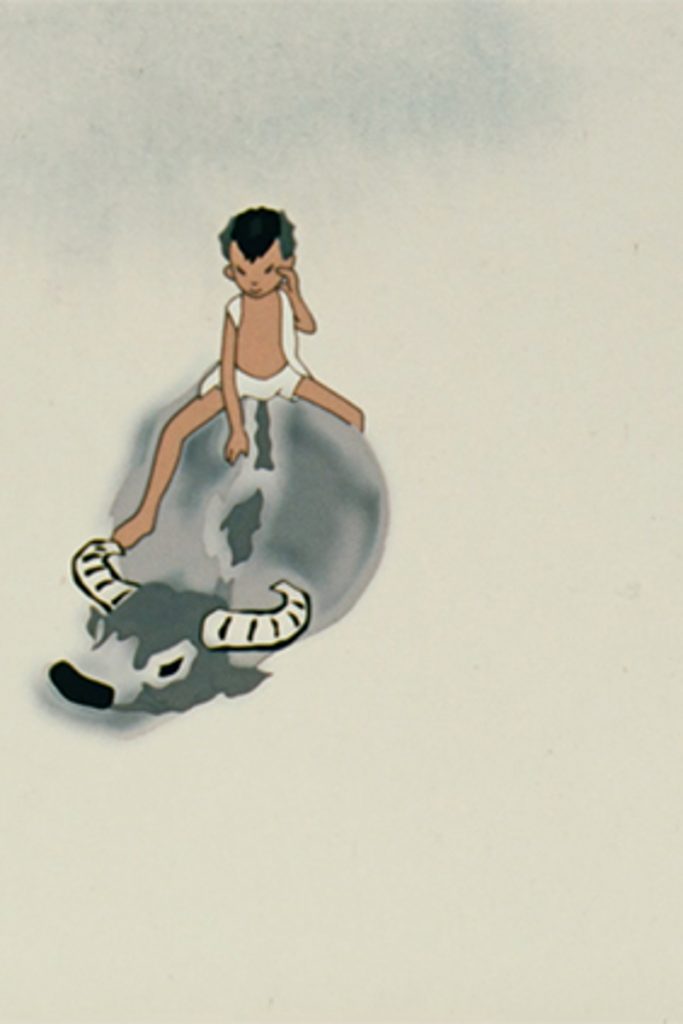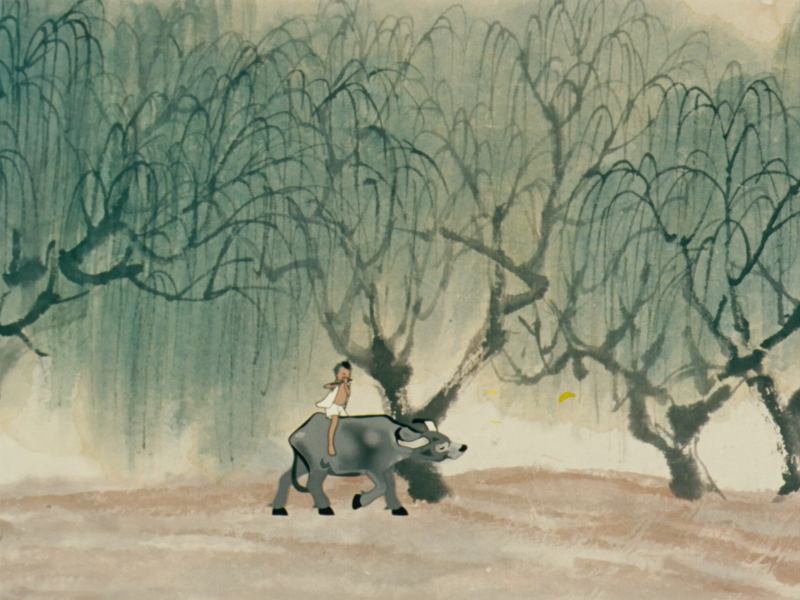Directors – Qian Jiajun, Te Wei – 1963 – China – Cert. N/C U – 20m
*****
A flute-playing forest boy loses then is reunited with his beloved water buffalo in the mountains. – available to rent online in the UK & Ireland as part of the Shanghai Animation Film Studio Retro in the Chinese Cinema Season 2021 from Friday, February 12th to Wednesday, May 12th
This opens with a lengthy panning shot of a forest drawn with pen and ink in a distinctive Chinese style not entirely dissimilar to the animated opening of the Japanese live action feature The Mad Fox (Tomu Uchida, 1962) but without the chaos or violence. Among the ink and watercolour-rendered trees wanders a boy playing a flute as he rides a slow moving buffalo, rendered like the backgrounds in pen and ink so that the effect is not of watching clumsily moving images over exquisitely rendered backgrounds, as has often been the case in Western animation departing from the 2D Disney model, but rather of watching a seamlessly moving brush and ink painting. Te Wei had already done this with his groundbreaking Where is Mama? (1960) and he pulls off the same trick again here.
It’s therefore no surprise that there’s a sequence of fish swimming around a river reminiscent of Where is Mama? or that the water buffalo and his rider move around in its three-foot deep water affording Te the opportunity to play around with an almost but not quite plain white background as the buffalo moves leisurely around. The boy playfully splashes the beast’s head, which it appreciates presumably because it keeps it cool in the baking tropical heat. Then he urges it forward and starts playing his flute again.

The boy lazes halfway up a tree and the sound of chirping insects something like crickets or cicadas gives way to a birdsong by a distinctively animated bird, a music fight with which the boy joins in on his flute. The bird moves around slender branches which wobble under her weight as she does so with the grace of an extremely skilled danger. The boy reminds me a little of the Bacchus figure in the Beethoven’s Pastoral Symphony section of Disney’s Fantasia (Forde Beebe Jr., Jim Handley, Hamilton Luske, 1940), but he’s much less boisterous and doesn’t look in the least like a Disney cartoon character – which is impressive when you think how much Disney dominated the international animation industry at this time.
There’s a wonderful sense of shimmering heat as the boy lies in his tree, conveyed in part by leaves slowly disappearing into a white heat haze the further away they are from the camera, an effect difficult to achieve in live action where you aren’t afforded the degree of control of such things as you are in animation. (Today you might start manipulating your images with CGI, but such contemporary special effects constitute a form of animation and in the 1960s such tools simply weren’t available.) Falling leaves again recall Fantasia, this time the Tchaikovsky Nutcracker Suite (Samuel Armstrong, 1940) before they turn into a pair of dancing butterflies. The focus shifts from the boy in the tree to the water buffalo below are he follows the butterflies around and frolics with them (again, strong echoes of Fantasia‘s Pastoral, Forde Beebe Jr., 1940).
The creature soon gets lost in the nearby mountains and the boy hitches a ride on a punt along the river and seeker advice from a couple carrying faggot bundles and boys minding their own buffalo herd before heading off into the mountains himself to find the beast. He lies gazing for a while at a vast section of waterfall which in one astonishing pan from top to bottom conveys an incredible sense of vertigo before another shot reveals the buffalo sitting peacefully on a bridge formation towards the bottom of the falls. He runs down a slope to joyously greet the animal as they are reunited. However, the creature decides it doesn’t want to play ball – first it won’t budge, then it runs off in the opposite direction.
The boy gives up, goes to a bamboo forest where he fashions himself another flute and starts playing, luring the beast back. There’s a lovely sense of the majesty of the mountains in all this, with first deer on outcrops of rock and then a whole series of birds of different types pausing to listen, culminating in a whole flock of one specific species flying in and landing to do so. Sure enough the buffalo trots back, and the boy embraces it. In fact, he’s embracing a tree trunk and has been asleep the whole time! A few notes on the flute soon attract the buffalo who isn’t far away and the boy sits astride him as they wander off into the distance together.
The whole succeeds without resorting to either the frenetic merrymaking of Fantasia‘s Pastoral or the narrated verbal story of Where Is Mama? – not a single word is spoken, yet the simple story is beautifully told in a mixture of breathtaking if languorously slow moving images. A gentle, captivating gem which has stood the test of time well.
The Cowboy’s Flute is available to rent online in the UK & Ireland as part of the Shanghai Animation Film Studio Retro in the Chinese Cinema Season 2021 from Friday, February 12th to Wednesday, May 12th.
Free to watch: The History of Shanghai Animation Film Studio
